Guest post, from Saoirse Hayes Hooper, Grade 5
Editor’s (AKA “Mom”) note: I have been reflecting lately on how best to improve my daughters’ experiences when learning to write. I feel like they both have a good command of language, and they are wonderful story tellers. However, I do feel that the homeschool setting can present a challenge in one area: audience. The single greatest pleasure in writing is in being able to communicate with a reader. Thus, since this report that Saoirse has just written seems timely with the upcoming Thanksgiving holiday, I thought I’d let her share her writing with you in hopes of giving her the pleasure of having readers. Thanks for reading and being part of our homeschool experience! Shannon
Introduction
When the Pilgrims first set foot on the shores of what is now known as America, they were met by the Wampanoags, the native people who had lived here long before the Europeans arrived. This report is about how these two very different cultures lived during the mid-1600s.
Part One: The Wampanoags
Language, Homes and Lifestyle
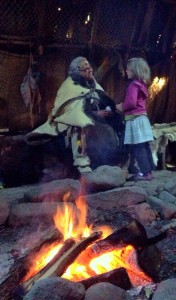
Inside a Nush Wetu, a Wampanoag home.
The Wampanoags spoke a language very different from what we hear in books and movies about “Indians.” A Wampanoag home is called a Nush Wetu, not a “teepee.” A dug-out canoe was called a mashoon.
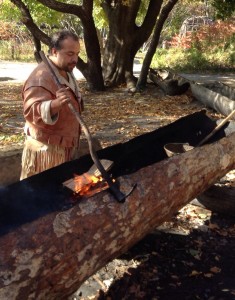
Making a mashoon (a dug-out canoe)
The Wampanoags survived by relying on their natural resources. They made fire from pyrite and quartz. They hunted, fished, and harvested their food from nature. They hunted with arrows, bows, spears, and knives made from stones, bones, and deer sinew. Some of the animals they used for food, clothing and tool making included beaver, rabbit, deer, bear, raccoon, muskrat, turtle, coyote, turkey, and duck. A common plant they used was milkweed. The women twisted it into fibers and made it into cloth, matts, diapers, and baskets.
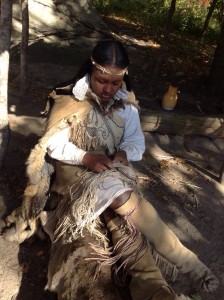
Using milkweed to make cloth.
Beliefs and Traditions
In a Wampanoag family or clan, each Nush Wetu housed three generations. The oldest grandmother of each clan was the teacher and babysitter. The younger women of the clan would do the cooking and gardening, while the men did the hunting and fishing. The Wampanoag greeted each other by saying “Wuneekeesug,” which meant, “I honor your presence, and how are you?”
Food
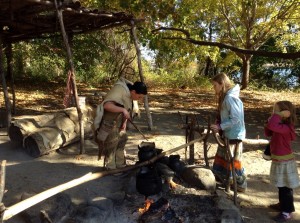
Cooking a mid-day meal of duck soup, parched corn and nessam.
In a Wampanoag village, the women were in charge of cooking and gardening. In their gardens, they grew corn, beans, and squash, known as “the three sisters,” because they helped each other. The corn provided a pole for the beans; the beans put nitrogen in the soil; the squash shaded the base of the corn and beans, and kept away pests and weeds. The Wampanoag people cooked over outdoor fires. Some of the foods they ate were: duck soup, parched corn, raspberry and blueberry leaf tea, and a type of cereal made from ground corn boiled with fruit, nuts and seeds, called nessam.
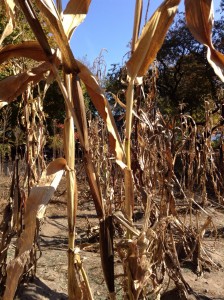
A Wampanoag garden
Part Two: The Puritans
Language, Homes and Lifestyle
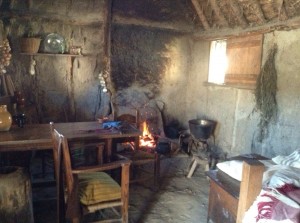
Inside an early Puritan home.
During the 1600s, the next door neighbors of the Wampanoags were the Pilgrims, who settled nearby on Plimoth Plantation. No one in Plimoth had their own houses. They all belonged to the company that had paid for them to sail from England to what is now America. Around Plimoth there was a large fence, called a palisade, to protect the plantation from invaders.
The Pilgrims made very little. Almost everything they needed came from England, such as cloth, tools, sugar, and butter. They did have gardens and livestock, but only a few animals, which they used mainly for breeding stock. Their gardens were small.
Beliefs and Traditions
In England, Separatists were outlawed, which the Puritans thought was unfair. So they set sail for a place where they could worship God in their own way. Not everyone on the Mayflower was a Separatist, but those beliefs and practices became the community law. In Plimoth, Christmas was outlawed: no carols, no tree, and no presents. Christmas was not celebrated. Surprisingly, some people who weren’t part of the Puritan faith were not even allowed to celebrate their own feast days, if they were different from the Puritans.
Food
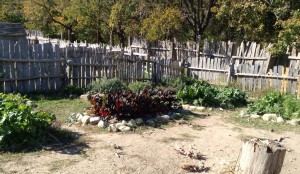
An early Puritan garden
The food the Puritans ate was very plain. In their gardens, they grew beets, squash, beans, swiss chard, herbs, and corn. A Puritan midday meal (or lunch, as we call it), could be Indian corn bread topped with sautéed onions, bread and butter, and boiled (called sod (sp?)) eggs, and game.
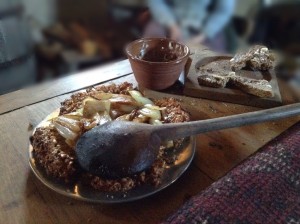
A simple midday meal of Indian cornbread with sautéed onions and bread and butter.
In England, due probably to pollution, water was often unhealthy to drink. But here in the colonies, the Puritans were surprised that the water didn’t poison them. The Puritans found that they could not grow enough barley here to make beer. Everyone, including children, was used to drinking beer, because the water where they came from had been so bad. But in the colonies, they were able to drink the water instead.
I would imagine that Indian corn bread, sod eggs, plain water and game don’t sound very appetizing to you, with all the other options we have today for food, such as pizza, macaroni, and sandwiches, but this was all they had back then!
Conclusion
I hope you enjoyed this report about the lifestyles of these two cultures who survived side by side in the 1600s. To write this report, my family and I took a trip to Plimoth Plantation. We learned a lot, and we hope you did, too!
Ps: Special thanks to Dad, Ula, and Mom. Also, to my grandparents, who took care of the dogs while we were gone.
Thanks Saoirse! I Learned things I did not know before about the Wampanoags. I used to live in Brocton, MA and worked at a college named after one of the most famous of the Wampanoags. Chief Massasoit. He was famous for making peace, and helping his neighbors in Plimoth survive their first winter.
Thank you for your report on the Wompanoag Indians and the Puritans, Saoirse. I found it clear, concise and interesting. It sounds like you really enjoyed the subject and your curiosity is catching, now I want to learn more!
Wow Saoirse. Your report is really well written. Thanks for teaching me a bunch of things I did not know!
Well done, Saoirse! I teach English at a small private school in a small town in the Great Karoo in South Africa. I am impressed with your report, it is clear, easy to read and really interesting. You taught me things I hadn’t known before. I LOVE teaching writing and I tell all my pupils that when you write about your own experiences your work is full of LIFE, which makes it so much more interesting. The secret about writing stories ( creative writing) is to include some of your own experiences but to cast a storyteller’s spell and transform reality into wonderful adventures. Perhaps we’ll read some of your stories here one day?
We started our school as a home school for two cousins whose parents wanted them to study their subjects in English, the schools in Prince Albert teach everything in Afrikaans. Then all their cousins joined them (and we were eleven) and then a friend came too … now we have seventy pupils! Although we are a registered school people find the atmosphere isn’t what they would expect, we have managed to keep some of the home-schooling aspects you and your sister are so fortunate to experience.
If you’d like to read about our town, Prince Albert, you can visit http://www.princealbert.org.za
best wishes to your Mom and Dad and Ula. KEEP WRITING!
Ailsa
I love an education piece with pictures. Descriptions of food and what housing was like always intrigue me (born homemaker, I guess).
Thank you, Saoirse for your report! It reminded me of the different places my husband and I visited, such as the Continental ship in Boston(?), Fort Pulaski in the South, and lately Batsto village close to where we live in south NJ. While my husband was interested in the battles and locations where the ships and particulars of the fort construction, what fascinated me was how the people lived and survived. These were our ancestors, who bravely lived life back then with all it’s hardships, and I am always thankful to be living in the time we live now, thanks to the perseverance of those who lived before us.
Saoirse, I really enjoyed your report and actually shared it with my brother in Seattle. He has been trying to teach his five yr old daughter about Thanksgiving without the misinformation currently peddled in American schools today. Thanks!
Theresa
This is terrific Saoirse. I didn’t know about these native people so it was fun to learn about the way they lived I too enjoyed the pictures.
You made a really nice choice to parallel them to the Pilgrims. It allowed me to draw my own conclusions about the choices each group made. And I would’ve loved to hear even more about what you thought about that comparision. Were there any advantages to how the Pilgrims chose to live, or any disadvantages to Wampanoags that would’ve surprised me?
Oooh, that would’ve been fun.
thank you for sharing your writings with us!
Thank you, everyone, for taking the time to read and comment on Saoirse’s report. I think it has been very important for her to see that her work is valued by other people. I, too, am appreciative of your comments, as you have given me ideas about how I can probe further as her teacher, and how to explain more about this craft. I suspect this lesson will come back to us many times over in the coming months as she wraps her head around the power of writing as a tool for communication. Saoirse is still presently unsure what to make of your comments…save to smile widely…then regard me with suspicion (she has expressed concern that now I am going to make her take over the blog…). Ula, on the other hand,has already expressed readiness to commandeer RadicalHomemakers.com.
Saoirse, I am so happy I did not get to see this before it was published. The writing and photos were beautiful. I know this project was not what you wanted to do, but you did it with such respect for the cultures.
Since it is 9 degrees here right now! what clothing would each of these groups have worn outside. Love Grammie
Just catching up with blog posts. This report is excellent; informative, well organized, very well written. Your understanding of this topic is impressive. I loved that your “editor” gave you the opportunity to publish your project for all the blog readers to enjoy.